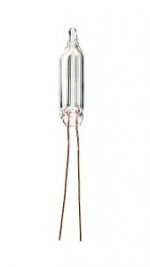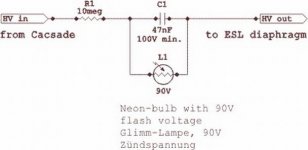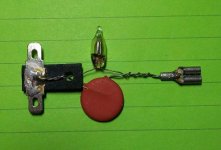I recently bought a pair of these, condition unknown.
One was dead, the other had a split bass panel.
I took out the eht boards and replaced all the diodes, caps and resistors.
I measured the resistance of all the crossover resistors and they are ok, just, high but within % tolerance of their values.
I took apart the broken bass panel and made a new diaphragm.
I put one back together and tested it and it worked. I just swapped in my newly rebuilt bass panel and it also works.
I think there may still be issues though. Bear in mind i have only tried using one speaker so i havent used them as a pair. I also havent had them plugged in for more than an hour.
But, the one on its own is quiet, far quieter than my tannoys. It also sounds a little muffled maybe but its hard to tell.
I realise i should stop being inpatient, fix the last dust cover, get them fully back in one piece and leave them plugged in for a while but it just doesnt sound quite right to me.
My amp is a PP el84 valve amp. I have tried it set at 8 ohm and 4 ohm. I have used this amp with esl63's before and they sounded great. The tannoys i use now i did direct comparisons with my esl63s with and i decided to sell the esl63 and keep the tannoys. This is why i have some idea that the esl57s might not be quite right still, even though i havent properly tested them.
Are there any other issues i should be looking for? Panels seem ok, no rivet
corrosion visible either. Eht units should be fine (i didnt test anything, just replaced all components), audio transformers must be ok, crossover components test ok, there isnt much else to go wrong!
One was dead, the other had a split bass panel.
I took out the eht boards and replaced all the diodes, caps and resistors.
I measured the resistance of all the crossover resistors and they are ok, just, high but within % tolerance of their values.
I took apart the broken bass panel and made a new diaphragm.
I put one back together and tested it and it worked. I just swapped in my newly rebuilt bass panel and it also works.
I think there may still be issues though. Bear in mind i have only tried using one speaker so i havent used them as a pair. I also havent had them plugged in for more than an hour.
But, the one on its own is quiet, far quieter than my tannoys. It also sounds a little muffled maybe but its hard to tell.
I realise i should stop being inpatient, fix the last dust cover, get them fully back in one piece and leave them plugged in for a while but it just doesnt sound quite right to me.
My amp is a PP el84 valve amp. I have tried it set at 8 ohm and 4 ohm. I have used this amp with esl63's before and they sounded great. The tannoys i use now i did direct comparisons with my esl63s with and i decided to sell the esl63 and keep the tannoys. This is why i have some idea that the esl57s might not be quite right still, even though i havent properly tested them.
Are there any other issues i should be looking for? Panels seem ok, no rivet
corrosion visible either. Eht units should be fine (i didnt test anything, just replaced all components), audio transformers must be ok, crossover components test ok, there isnt much else to go wrong!
The original diaphragm coating on the Quad 57's evaporates over time, and they can take a LONG time to charge up (depending on condition), until they are fully charged the tonal balance can be a little strange particularly if the treble panel is lagging in charging up. They will sound like there is a blanket over the speaker. The 63's will be tonally more uniform as it charges because the mid panels cover the whole spectrum, but the 57's have different diaphragms for different frequency ranges.
I wouldn't make any conclusions about the speaker until you let it charge.
Sheldon
I wouldn't make any conclusions about the speaker until you let it charge.
Sheldon
The original diaphragm coating on the Quad 57's evaporates over time, and they can take a LONG time to charge up (depending on condition), until they are fully charged the tonal balance can be a little strange particularly if the treble panel is lagging in charging up. They will sound like there is a blanket over the speaker. The 63's will be tonally more uniform as it charges because the mid panels cover the whole spectrum, but the 57's have different diaphragms for different frequency ranges.
I wouldn't make any conclusions about the speaker until you let it charge.
Sheldon
Thanks, i hope that is the case. Rebuilding the bass panel wasnt too bad a job. If i needed i guess i could rebuild them all.
I used graphite on the membrane, it seems to have worked ok, but if i do them all id be looking for something better.
Guess i should read the esl coating mega thread!
Not sure exactly what you mean with the neon lamps. The original lamps work, but they only tell you when they are plugged in.
I made a jig to stretch the diaphragm. I cleaned it with alcohol, rubbed graphite in with paper towel then cleaned off with alcohol again. It seems to have worked well.
I made a jig to stretch the diaphragm. I cleaned it with alcohol, rubbed graphite in with paper towel then cleaned off with alcohol again. It seems to have worked well.
Graeme, how did you stretch the bass diaphragm? Did you rub in graphite powder with a cotton pad and alcohol? Inserting neon lamps in series at HT outputs for checking leakage is also a good idea.
This neon oscillator works well. Remember you have to put a capacitor parallel to the neonbulb
This neon oscillator works well. Remember you have to put a capacitor parallel to the neonbulb
I still dont really understand what your suggesting. Im happy building circuits (i built my amps) but i dont understand the theory, can only follow schematics.
I mean just connect the above depicted neon bulbs (you need three) in series with the bias high voltages coming from the voltage multiplier PCB. There are three wires, two going to the left and right bass panels' diaphragm (+6 kV), one going to the mid/high panel diphragm (+1.5 kV). If there is any leakage on either panel, current is flowing and the neon bulb will flicker. This is a good visual indication.
Inserting neon lamps in series at HT outputs for checking leakage is also a good idea.
This talk of neon lamps.....I have one Quad 57 blub that flashes all the time, one flashes every min an thay sound the same....
So I get the theory...but if the panel too bad to play... anyone can tell buy bad sound....dose any one need to care what the blub dose less thay can fix Quad ESL speaker?
What good well come from knowing .. Owners need to get rit of these speakers...that need to be work on all the time....Oh,I got them fixet...but blub till flashing...Nuts
People post as if this well make the speaker sound better with the blub in bias setup of ESL....
I have had an still have a lot of ESL speaker in the 40 years I been in this hobby ….Only the Quad has the flashing blub too drive most owners nuts...with a flashing bulb that you the user can do nothing about...but think bad thoughts about Quad....oh boy that's great....
Just my 2cent
This talk of neon lamps.....I have one Quad 57 blub that flashes all the time, one flashes every min an thay sound the same....
So I get the theory...but if the panel too bad to play... anyone can tell buy bad sound....dose any one need to care what the blub dose less thay can fix Quad ESL speaker?
What good well come from knowing .. Owners need to get rit of these speakers...that need to be work on all the time....Oh,I got them fixet...but blub till flashing...Nuts
People post as if this well make the speaker sound better with the blub in bias setup of ESL....
I have had an still have a lot of ESL speaker in the 40 years I been in this hobby ….Only the Quad has the flashing blub too drive most owners nuts...with a flashing bulb that you the user can do nothing about...but think bad thoughts about Quad....oh boy that's great....
Just my 2cent
I get what your saying. The neons on my 63's did nothing other than help me prove their condition to the guy i sold them to.
For me though, it would be handy to know if the panels are charging too often as i could actually do something to fix them.
Still not sure i get what to put where though. Ive read about a resistor too. Can anyone draw up a diagram?
For me though, it would be handy to know if the panels are charging too often as i could actually do something to fix them.
Still not sure i get what to put where though. Ive read about a resistor too. Can anyone draw up a diagram?
Back in the early 90s I wired up a neon charge indicator to quick-disconnect terminals.
I still have it in my test kit...very handy for troubleshooting ESLs that don't have one built in
More details on its use and Quad ESL63 schematic here:
ESL technical questions
I still have it in my test kit...very handy for troubleshooting ESLs that don't have one built in
More details on its use and Quad ESL63 schematic here:
ESL technical questions
Attachments
Inserting neon lamps in series at HT outputs for checking leakage is also a good idea.
This talk of neon lamps.....I have one Quad 57 blub that flashes all the time, one flashes every min an thay sound the same....
So I get the theory...but if the panel too bad to play... anyone can tell buy bad sound....dose any one need to care what the blub dose less thay can fix Quad ESL speaker?
What good well come from knowing .. Owners need to get rit of these speakers...that need to be work on all the time....Oh,I got them fixet...but blub till flashing...Nuts
People post as if this well make the speaker sound better with the blub in bias setup of ESL....
I have had an still have a lot of ESL speaker in the 40 years I been in this hobby ….Only the Quad has the flashing blub too drive most owners nuts...with a flashing bulb that you the user can do nothing about...but think bad thoughts about Quad....oh boy that's great....
Just my 2cent
The neon bulbs in the power supplies in the original ESL's are purely ornamental. They serve NO other purpose than to show that you have the speakers plugged in.
Sheldon
Back in the early 90s I wired up a neon charge indicator to quick-disconnect terminals.
I still have it in my test kit...very handy for troubleshooting ESLs that don't have one built in
More details on its use and Quad ESL63 schematic here:
ESL technical questions
I posted this in the diaphragm coating thread. That neon bulb flash rate is directly proportional to the current flowing into the panels.
Current vs blink rate for ESL63’s:
Q = C * V
Q = 47e-9 * 90
1A = 1Q/sec
Rate = 4.23e-6 amps / 1 sec blink
BTW, this is not 100% correct, it assumes that when the neon strikes (at 90V) that is completely discharges the cap. In reality the lamp will extinguish at about 50 volts, so that "90" above should really be about 40. Or about 2uA/sec blinks
Sheldon
Last edited:
- Status
- This old topic is closed. If you want to reopen this topic, contact a moderator using the "Report Post" button.
- Home
- Loudspeakers
- Planars & Exotics
- Quad esl57 issues


